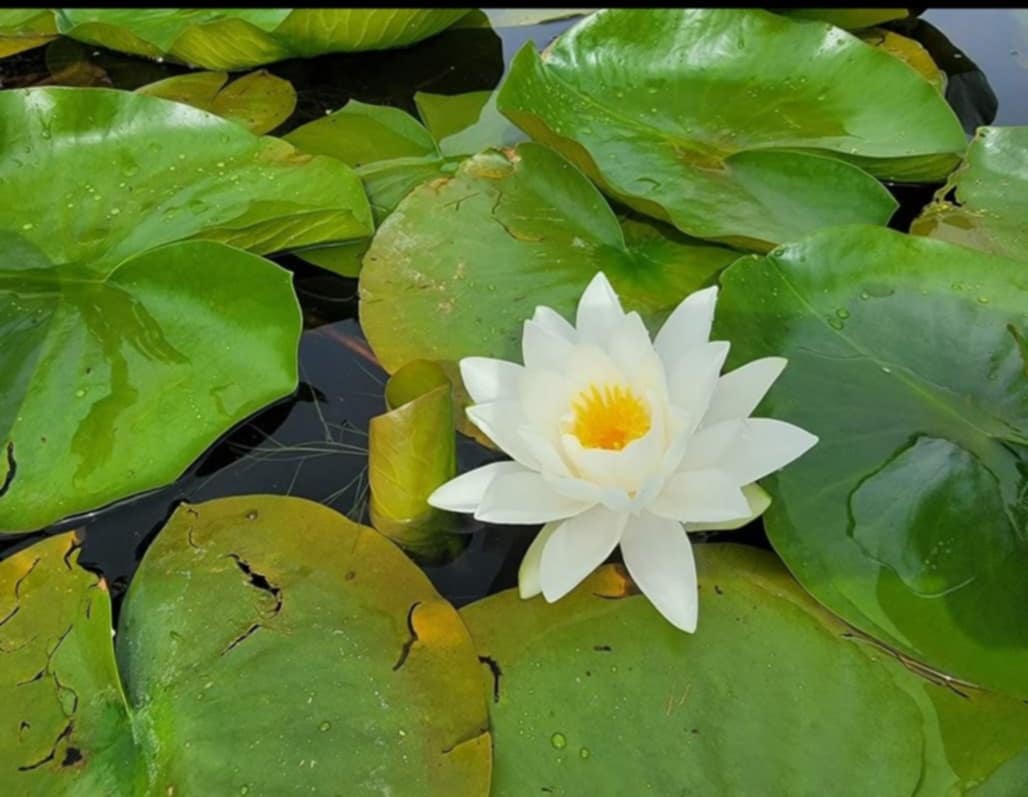Katie Byerly of Cerro Gordo County is also known as Iowa Prairie Girl on YouTube. Click here to watch her video on American white water-lily.
The water-lily doesn’t need much of an introduction. If you’ve seen a large white flower floating on a body of water, chances are that flower was an American white water-lily (Nymphaea odorata).
These plants like still or slow-moving water—usually a shallow lake, pond, or marsh with a mucky soiled bottom. Water-lilies will form colonies and cover a large surface of water. Their brilliant white flowers are scattered on the water like polka dots with their shiny lily pads surrounding them.

These images show the colony of white water-lilies on the pond at Wilkinson Pioneer Park in Rock Falls, Iowa (Cerro Gordo County).

The leathery leaves or lily pads are waxy, thick and water resistant. They are dark green on the top and light green and purplish on the bottom. The circular leaf can grow to be a foot wide.

Floating on the surface, the large pads shade the sun, keeping water temps cool. Animals below and above use the pads for either hiding under the leaf or landing on top of them.

The lily pad has a “V” cleft on the bottom where the long stem attaches in the center of the leaf. This stem can be 6 to 8 feet long and attaches the plant to the bottom of the pond to a rhizome/bulb. This rhizome is spongy as it is full of air. The water-lily adds oxygen to the body of water where it grows.

Each plant has one flower, which has its own long stem coming up from the bulb at the bottom of the pond.

The snow white flower is 3-6 inches across with 20-30 petals. The petals curve upward.

The center is full of yellow stamens.

Water-lilies have a lovely sweet fragrance. I understand there might be two species, one known as Fragrant water-lily. Other sources list white water-lily and fragrant water-lily as alternate names for the same species (Nymphaea odorata). For amateurs like myself, it’s OK to lump them together.
The flower opens at daylight and closes at dark. The four waxy light green sepals holds the flower closed at night; during the day, it keeps the flower afloat.


Look closely here for the sepals spread out supporting the flower underneath.

The flower blooms for just four days. We don’t get to see a spent bloom, as the flower turns downward into the water on day four. After the seeds develop, they get dumped into the water where they either float around, sink to the bottom of the pond, or get eaten by ducks and fish.
Like most wildflowers this plant has a few common names. Some of those fun names are beaver root, water cabbage, and water nymph. American white water-lily is truly an amazing plant, from the way it provides shelter and food to animals to how it cools and provides oxygen to the water.

For more about this super plant, see my video on my Iowa Prairie Girl YouTube page.


1 Comment
Thank you for the happy memory...
…of seeing this beautiful flower, long ago, from a canoe.
PrairieFan Wed 21 Aug 7:17 PM